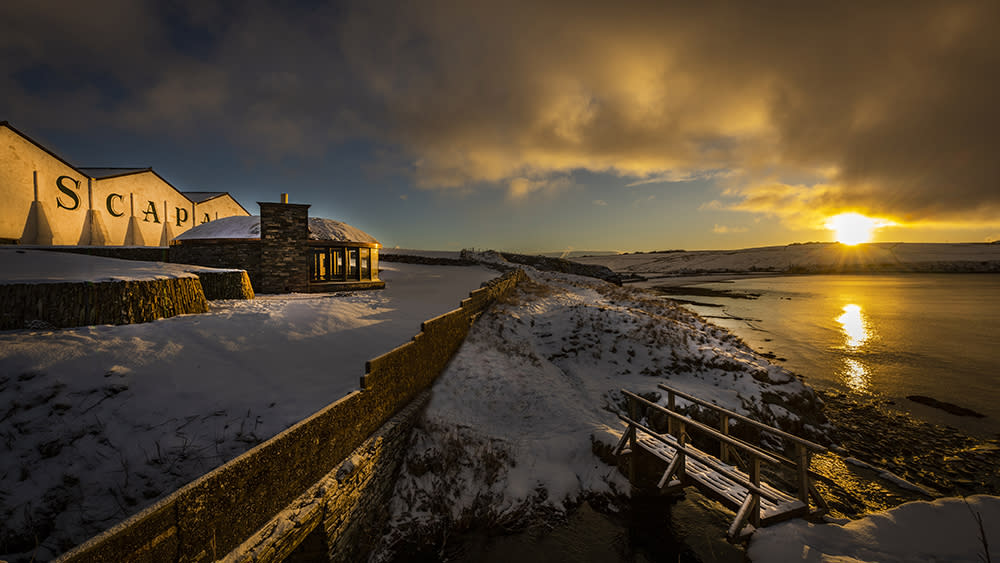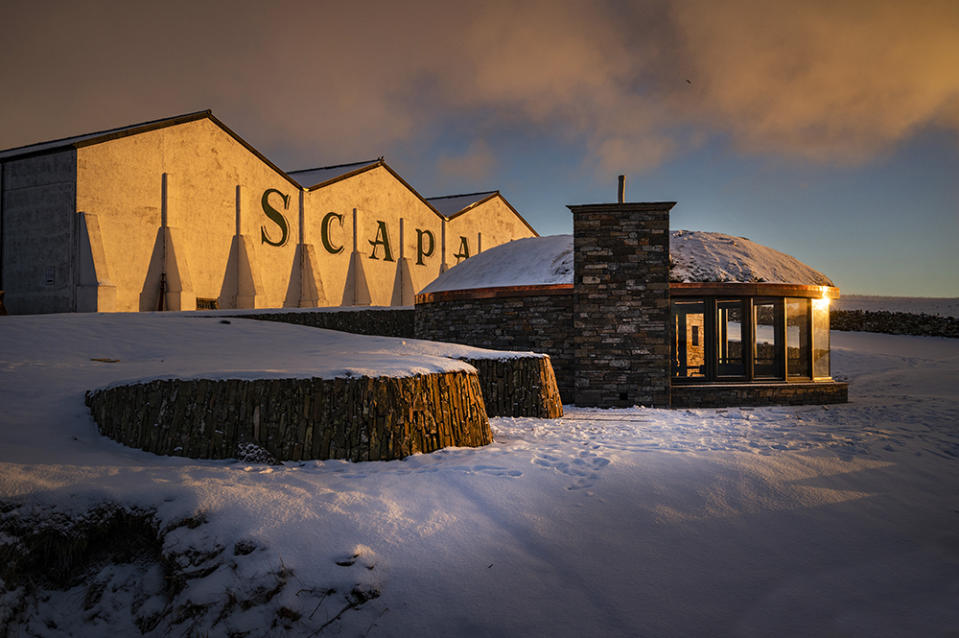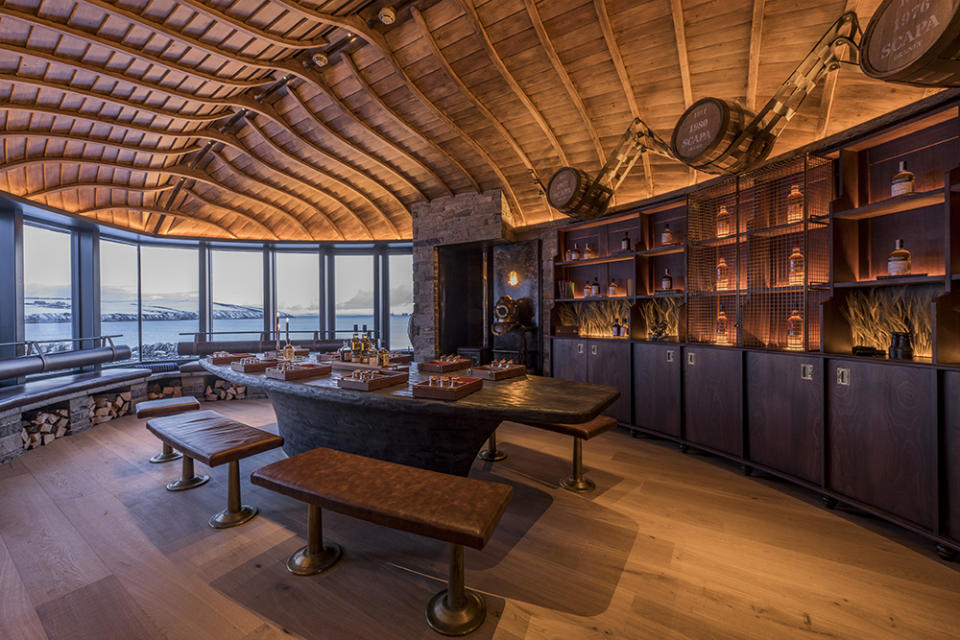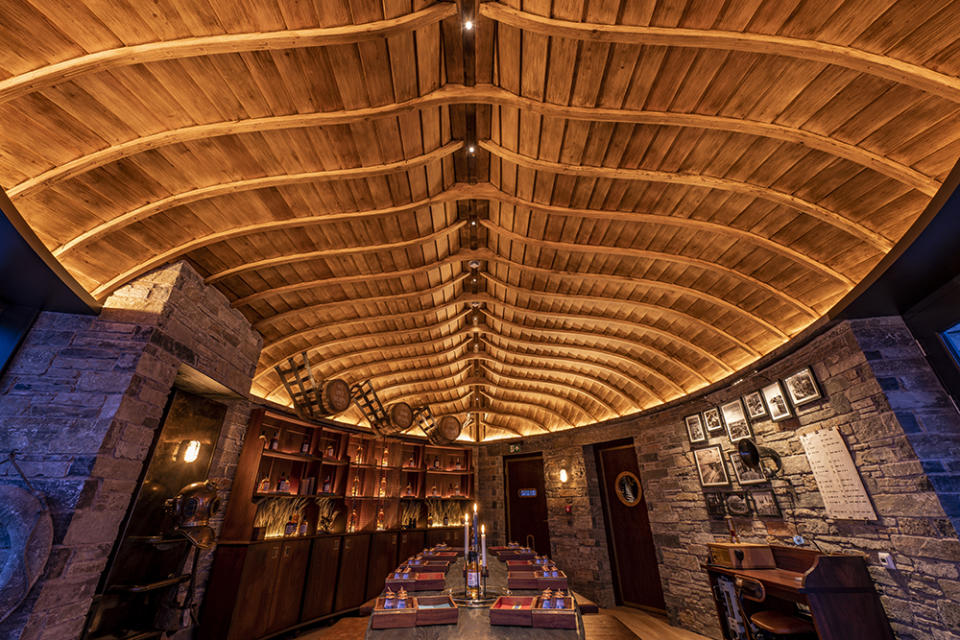Why This New Whisky Tasting Room in Scotland’s North Sea Archipelago Is Worth the Journey

Whisky inspires wanderlust. That’s why for a great number of Scotch-soaked sippers, sitting in a musty tartan distillery room with a medically pungent peat-bog-infused dram as a mournful piper plays is well worth the airfare. But once you’ve bent your elbow a time or 10 in the inner Hebrides—on Jura, Islay, and Skye—it’s time to escort your palate off the beaten track.
In April, the Scapa Distillery in Orkney, the isolated North Sea archipelago off Scotland’s top right corner, opened an elegant new tasting room overlooking its namesake Scapa Flow—the site of many a tragic shipwreck and naval legend. Known as the Noust, local seafaring dialect for a safe haven, the room promises to redefine the experience of whisky tasting, which, in terms of vibes, too often sags somewhere between golf club and corporate away-day.
More from Robb Report
Japanese Whisky Lovers Rejoice, Nikka Is Bringing Back It's Age-Statement Single Malt
This $11.8 Million Scottish Estate Will Instantly Turn You Into a Baron or Baroness
The interior of the Noust is dominated by an undulating wooden ceiling that replicates the structure of local fishing boats known as yoles, offspring of the longships once used by Orkney’s Viking overlords. The 70 islands belonged to Norway from 875 until 1472, and the local DNA, dialect, and culture remain distinctly Norse, in contrast to the Irish Gaelic heritage of the Hebrides.

The weather in Orkney is mild but wild year-round, with skies that switch between sun and showers several times a day, buffeted by a stiff wind.
Mark Fresson, a director at Norr, the global architecture practice that designed the Noust, took inspiration from the yole, as well as from the 5,000-year-old stone dwellings at nearby Skara Brae, the best-preserved Neolithic settlement in Western Europe.
From the outside, the Noust resembles a rather chic hobbit hole, with floor-to-ceiling windows. Inside, the stone walls, brass-trimmed cabinetry, and leather-upholstered stone benches create a strong sense of a haven, when set against the ever-changing vista of sea and sky (the Northern Lights make an occasional appearance). Scapa Flow, one of the world’s largest natural harbors, has sheltered Vikings, Norwegian kings, pirates, and the Royal Navy. In this bay, at the end of the First World War, the German High Seas Fleet scuttled its own ships rather than hand them over to the victorious Allies.

Sea views from island distillery tasting rooms are “almost unknown,” says Jacques-Henri Brive, head of brand experience and advocacy at Chivas Brothers, the owners of Scapa since 2005. Brands such as the Macallan, in Speyside, and Talisker, on the Isle of Skye, have impressive modern tasting rooms and offer innovative immersive experiences, but none can command the sense of awe and raw nature on offer at Scapa.
A tiny operation founded in 1885 by ex-Highland Park distillers who wanted to move away from peaty island malts, Scapa is one of the last remaining manually operated distilleries. It remains highly traditional, using one rare Lomond still for distillation. The 12,000 casks in Scapa’s warehouse are produced using a 160-hour fermentation process, the longest in Scotland. This protracted marination “perfectly reflects the style of Orcadian living,” said Caris Simpson, global brand ambassador for Chivas Brothers’ range of single malts, which includes the Glenlivet and Aberlour. “Island life, and I can say this as a Highlander, it’s a little bit slower than anywhere else in the UK.”
The effect produced is spiritual in both senses, according to Maria Letizia Bardelli, Scapa’s visitor center supervisor. “Whisky-making is supposed to be scientific,” she said, “but it’s actually dark magic.”
Tastings included three Distillery Reserve Edition malts: a dark, rich 14-year-old cask-strength malt finished in sherry butts and redolent of Christmas cake (828 bottles, about $122), a lighter, citrus-and-vanilla 22-year-old single cask edition (252 bottles, roughly $137), and a newly released 19-year-old Pedro Ximénez hogshead finish, mellow and faintly tropical (432 bottles, approximately $230).

Scapa’s range is sold online in the UK, with some rare bottles are only available at the distillery, including the Scapa Vintage Collection 41-Year-Old (1979), priced at roughly $15,500, and 42-Year-Old (1977), about $18,650. U.S. buyers in some states can buy certain Scapa malts on the Whisky Exchange—though not Distillery Reserve Edition whiskies. For those, you’ll need to visit in person.
Those making the pilgrimage to Scapa should make reservations at Hamnavoe, a new powerhouse of a restaurant in the small town of Stromness. Open for dinner on weekends and by private arrangement at other times (a buy-out is $3,700 in high season), Hamnavoe’s simple appearance belies its sophistication. The Korean-Scottish fusion menu focuses on local seafood, delivered to the back door by a diver. A typical lunch might include hand-dived scallops with butternut and miso puree, Orkney lobster with shiitake and ginger noodles, and Valrhona Illanka chocolate ganache with whisky, blood orange and macadamia nuts.
Most visitors to Orkney come for the 5,000-year-old burial mounds and standing stones that dot the pale-green fields, notably the vast, eerie Ring of Brodgar and Stones of Stenness. A 20-year-old dig at a large Neolithic settlement, the Ness of Brodgar, will close next year; visitors can tour the site for the last time this summer.
Other must-see Orcadian sights are the 12th-century St Magnus Cathedral in Kirkwall—home to a major annual festival of music and literature—Canada View—a World War Two cliff-top machine-gun battery where the Atlantic pounds towering sea-stacks and the Italian Chapel, a stunningly ornate Catholic church created out of steel huts by Italian prisoners of war.
Local guides, such as Paul Hudd of JP Orkney, have the low down on the best places to see minke whales, basking sharks, orcas, and dolphins, as well as arranging personal island tours with Malcolm Macrae, the 12th Laird of Breckness.
Orkney has no five-star hotels—yet. But on the mainland, one hour away by ferry, stands King Charles’ personal Scottish retreat, the 16th-century Castle of Mey, which offers simple B&B or self-catering rooms. The magnificently luxurious Gleneagles in Perthshire and the Fife Arms in the Cairngorms are a short hop by helicopter or private jet.
Orkney is refreshingly free of cliché; you will not find tartan, clans, bagpipes, or caber-tossing. What it offers is raw nature, a portal into deep history, a confident food and arts scene, and perhaps the most magnificent whisky tasting experience in the country.
Best of Robb Report
The Ultimate Miami Spa Guide: 15 Luxurious Places to Treat Yourself
The 7 Most Insanely Luxurious Spas in the World, From Tokyo to Iceland
17 Reasons the Caribbean Should Be at the Top of Your Travel Itinerary
Sign up for Robb Report's Newsletter. For the latest news, follow us on Facebook, Twitter, and Instagram.

